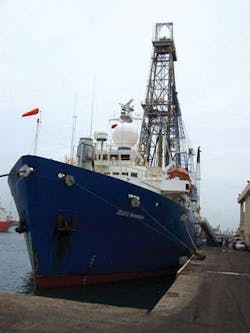US-India study discovers large gas hydrate presence
An international team led by the US Geological Survey (USGS) and India’s Directorate General of Hydrocarbons released the results Feb. 7 of what they describe as the world’s most comprehensive gas hydrate field venture to date.
In the Krishna-Godavari basin, India’s National Gas Hydrate Program (NGHP) Expedition 01 in 2006 delineated and sampled one of the richest marine gas hydrate accumulations ever discovered. The report said one of the thickest and deepest gas hydrate occurrences yet known was discovered off the Andaman Islands, with gas hydrate-bearing volcanic ash layers as deep as 600 m below the seafloor. It also said, “For the first time, a fully developed gas hydrate system was established in the Mahanadi basin.”
NGHP Expedition 01 was the first modern study of gas hydrates off the Indian peninsula and along the Andaman convergent margin with special emphasis on the geologic and geochemical controls on the occurrence of gas hydrate in these two diverse settings. It was planned to explore 10 sites in four areas: the Kerala-Konkan basin in the Arabian Sea on India’s western continental shelf; the petroliferous Krishna-Godawari basin and Mahanadi basin in the Bay of Bengal; and the previously unexplored Andaman Islands. Scientists conducted ocean drilling, coring, logging, and analytical activities to assess the geologic occurrence, regional context, and characteristics of gas hydrate deposits along India.
The riserless drillship Resolution was operated by Overseas Drilling Ltd. in a 114-day expedition for hydrate deposits off India. Photo from US Geological Survey.
Gas hydrates are a naturally occurring, ice-like combination of natural gas and water formed by high pressure and low temperatures in the world’s oceans and polar regions. In the 1990s, the USGS made the first systematic assessment of the volume of gas stored in gas hydrates. Estimates range from 2,800 to 8,000,000 trillion cu m of gas. Conventional natural gas accumulations (reserves and technically recoverable undiscovered resources) for the world are estimated at 440 trillion cu m, USGS reported.
Proponents speculate that this unconventional resource could be developed in conjunction with conventional gas fields. However, the technical challenges are substantial. Proposed methods of gas recovery from hydrates generally deal with dissociating gas hydrates in situ by heating the reservoir beyond the temperature of gas hydrate formation or decreasing the reservoir pressure below hydrate equilibrium.
“The combined wisdom of the scientific community from across the world could provide the answers and solutions to many of these challenges,” said V. K. Sibal, NGHP program coordinator and director general of the hydrocarbons directorate under India’s Ministry of Petroleum and Natural Gas.
During its 114-day voyage April-August 2006, the expedition cored or drilled 39 holes at 21 sites (one site in the Kerala-Konkan basin, 15 sites in the Krishna-Godavari basin, four sites in the Mahanadi basin, and one site in the Andaman deep offshore areas), penetrated more than 9,250 m of sedimentary section, and recovered 494 cores encompassing 2,850 m of sediment from 21 holes. Twelve holes were logged with logging-while-drilling tools at 10 sites, and an additional 13 holes were wireline-logged.
The expedition discovered gas hydrates in numerous complex geologic settings and collected an “unprecedented” number of gas hydrate cores and scientific data, USGS officials said. It collected vertical seismic profile data at six sites and detailed shallow geochemical profiles at 13 locations. It also established temperature gradients at 11 locations. It brought back an extensive sample collection to support a wide range of postcruise analyses, including:
- 6,800 whole round-core samples for examination of interstitial water geochemistry, microbiology, and other information.
- 12,500 core subsamples for paleomagnetic, mineralogical, paleontological, and other analyses.
- 140 gas-hydrate-bearing sediment samples for storage in liquid nitrogen.
- Five 1-m-long gas-hydrate-bearing pressure cores for analysis of the physical and mechanical properties of gas-hydrate-bearing sediment.
- 21 repressurized cores (9 representing subsamples from gas-hydrate-bearing pressure cores).
Workers conducted 97 deployments of advanced pressure coring devices, resulting in the collection of 49 cores that officials said “contain virtually undisturbed gas hydrate in host sediments at near in situ pressure conditions.”
The NGHP expedition was “a monumental step forward in the realization of gas hydrates becoming a viable energy source,” said USGS Director Mark Myers.
A technician measures the temperature of a core. The expedition recovered 494 cores with 2,850 m of sediment. Photo from USGS.
Global gas hydrate resources are estimated to be huge, presenting “unlimited” opportunities for exploration and exploitation, Sibal said. “The Indian gas hydrate program has been fortunate in having the benefits of a truly global collaboration in the form of the first gas hydrate expedition in Indian waters. The results of the studies are not only encouraging but also very exciting. I believe that the time to realize gas hydrate as a critical energy resource has come,” he said.
Participants in the NGHP expedition presented the results of that study at the 3-day Indian National Gas Hydrate Program Gas Hydrate Conference in New Delhi.
NGHP Expedition 01 was planned and managed by the Directorate General, the USGS, and the Consortium for Scientific Methane Hydrate Investigations, led by Overseas Drilling Ltd. and Fugro McClelland Marine Geosciences. The science team was led by Dr. Timothy Collett of the USGS and consisted of more than 100 scientists.
Overseas Drilling was listed as operating the riserless drillship Resolution that was provided by the Joint Oceanographic Institutions for Deep Earth Sampling (JOIDES). Drilling and coring equipment was provided by the Integrated Ocean Drilling Program (IODP) at Texas A&M University through a loan agreement with the US National Science Foundation. Wireline pressure coring systems and supporting laboratories were provided by IODP, Fugro, the USGS, and the US Department of Energy. Downhole logging operational and technical support was provided by Lamont-Doherty Earth Observatory of Columbia University.


